The Motorola Moto G4 and G4 Plus Review
by Brandon Chester on August 15, 2016 8:00 AM EST- Posted in
- Smartphones
- Lenovo
- Motorola
- Moto G
- Moto G4
Battery Life
Regardless of how good a phone's hardware is, if it can't last through the day then it's never going to provide a good user experience. We use a few different tests to analyze the battery performance of a mobile device under different workloads that put a heavy stress on a certain part of the system. In our web test, the workload is display-bound, although there is a significant amount of CPU processing done which will impact results. In GFXBench the test is GPU-bound, and in PCMark the test tries to simulate typical interactions that will make use of all the hardware. For these benchmarks I've opted to just test the Moto G4 Plus, as both the G4 and G4 Plus share the same SoC, display, and battery capacity, so there should be no difference between the two as far as battery life is concerned. As always, I'll start with our own WiFi web benchmark before moving to the battery tests that exist as part of the performance benchmarks that we use.
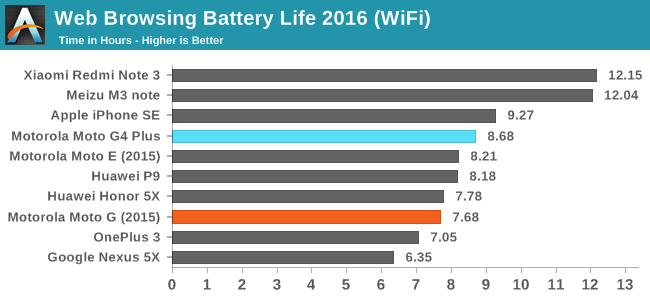
In our internal WiFi web browsing test the Moto G4 Plus lasts exactly one hour longer than the 2015 Moto G. This isn't surprising given the significant increase in the battery capacity with the move to a larger form factor, but it does put to rest any concerns about the Moto G4's higher resolution display leading to worse battery life in display-bound workloads than its predecessors.
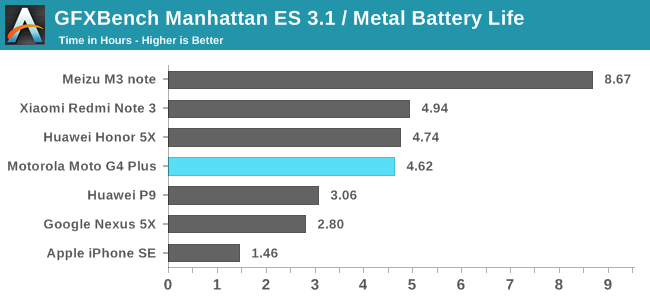
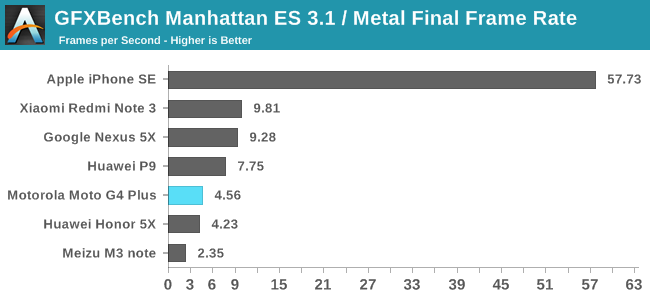
The Moto G4 performs as expected in the GFXBench Manhattan ES 3.1 battery test. Both the runtime and performance are in line with the Huawei Honor 5X, which has essentially the same specifications. Obviously a frame rate of 4.5fps isn't going to be playable, but in a graphical workload more reasonable for the Moto G4's hardware you should be able to play for a good period of time before your battery dies.
Normally I would run PCMark's battery benchmark, which is my favorite battery test because it performs tasks that users do on a daily basis. In my view it provides the best idea of whether or not a phone will last through the day. Unfortunately, I couldn't get the Moto G4 or the G4 Plus to complete the test. Early on in the benchmark it would simply freeze, and the phone would sit there in that state until it drained and died. I attempted the test three times, at which point I gave up on my attempts. The only other device this has happened to is the Google Pixel C, and we all know how that turned out. Suffice to say, this kind of issue is a hint that there are probably other software problems and stability issues in the phone's firmware, and it's not a good sign.
Charge Time
Something that I found to be quite ridiculous about previous versions of the Moto E and Moto G was the charger included in the box. This was market dependent to a degree, but in North America the first problem with the charger was that it had a low power output of roughly 2.5W. This meant that the phones charged incredibly slowly, which was a big problem when paired with the relatively large batteries in the 2015 Moto E and Moto G. On top of that, the charger was a single unit where the block and cord were connected together, rather than being a separate block and cord. This meant that by default, the Moto E and Moto G could not be connected to a computer to transfer media.
While the old charger could be somewhat excused as a cost saving measure, Motorola has clearly recognized the ridiculous nature of it. With the Moto G4 and G4 Plus they now ship a separate cord and charger. Something that confuses me is the fact that Motorola's website explicitly advertises that the G4 Plus ships with their 15W TurboPower charger. While this is the case, the normal Moto G4 unit I received also has it so it's not really a selling point for paying the extra $50 from what I can see. I'm not sure if this differs by market, so it's probably best to check the box when buying to see what charger you get inside.
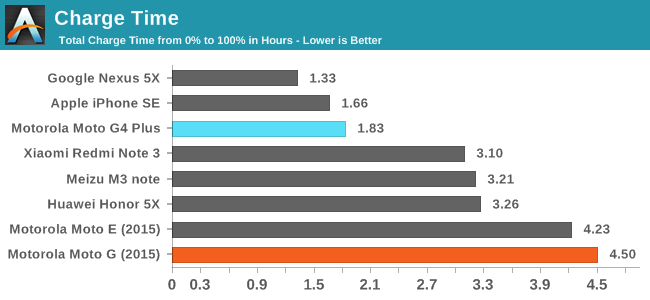
By including a reasonable charger in the box, Motorola has cut down charge time significantly. The 2015 Moto G had the longest charge time on record for a smartphone, while the Moto G4 Plus is in line with what is expected of modern smartphones. Fast charging has more than halved the time it takes to charge the battery fully, despite the fact that the battery has increased in size from 2470mAh to 3000mAh. My only complaint is that Motorola's TurboPower charger makes a whining noise when the phone reaches a full charge and is left connected. I noted this around the time of the Nexus 6 review as it uses the same charger, and I was told by many users that they don't experience this. However, I now have three of these 15W TurboPower blocks and they all do it, so I think it actually comes down to whether or not you can hear the frequency emitted. If you want to look on the bright side, it lets you know when your phone is done charging, but I think I'd rather have an LED indicator instead.


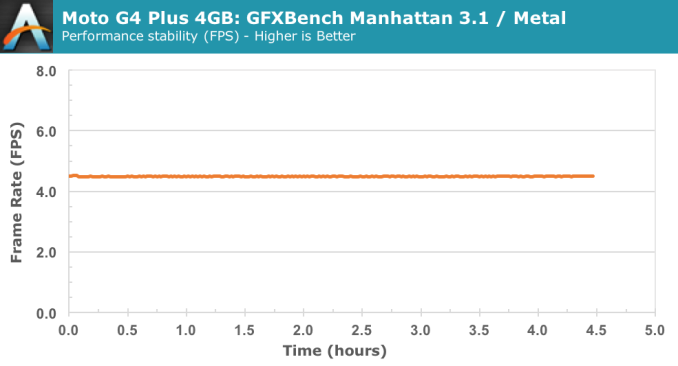
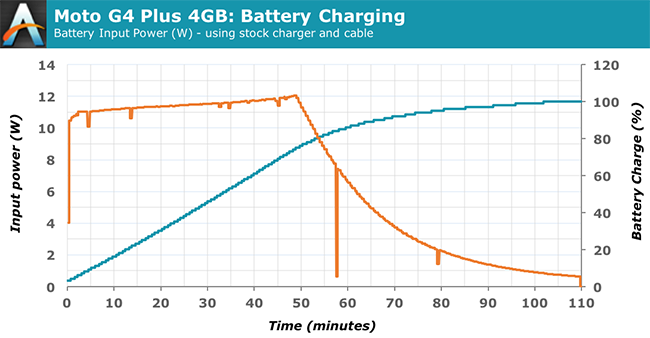








94 Comments
View All Comments
Dribble - Monday, August 15, 2016 - link
It is a fair point - there are very few good small phones, you've got the Sony Z? compact and that's about it. This has just released itself right into the mass of cheap chinese phones some of which are better.Tbh the original moto g nailed it - small phone with replaceable back for compact folding cover, good screen, good performance, good battery life. My son still has one, it still works, the screen still has 0 scratches due to great cover, the battery life is still acceptable. The subsequent moto g'd all got bigger, slower, worse battery life, etc. Whoever is in charge just doesn't have a clue imo.
All motorola had to do was produce something the same as the original moto g for 2016 and it would have had the whole market between cheap n nasty and the sony Z? compact. Been really popular with people who want a compact phone but don't want to spend a fortune and parents looking for a phone that will fit in their kids pocket and that they won't break in 5 minutes.
BrokenCrayons - Monday, August 15, 2016 - link
Larger phones are nice for the added screen space, but I do agree that 5.5" is too large. I prefer sub-4 inch screens since they're much more easily carried. Its comical to see people with belt holsters and huge, awkward protective cases wrapped around gigantic phones that are worn like cowboys in those silly western movies used to wear their revolvers. I'm just waiting for one giant phone owner to spit out tobacco and say "Draw pilgrim," to another giant phone owner. Then again, I think a lot of the appeal in larger phones is to show off technology while feeling trendy and well-connected. These days, the phone someone openly carries in a holster is as much a status symbol as the huge SUV that same person jammed into two parking spaces at their local grocery store.Michael Bay - Monday, August 15, 2016 - link
5.5 is too large, but sub-4 is too small. Where have all the 4.7s went? It was the best of both...markiz - Monday, August 15, 2016 - link
How can you have ANYTHING done on a sub 4" screen?Browsing, reading, looking at photos, satnav, ebooks, gaming.. None of these thing can be done on such a tiny screen with any level of comfort.
Michael Bay - Tuesday, August 16, 2016 - link
Well, if you actually use your phone as a PHONE, it`s handy.Foreign concept nowadays, I know.
johnsonx - Monday, August 15, 2016 - link
same here... having gone from 3" to 3.6" to 4.5" to 5" to 5.7" to now 6" in the last 5 years, I would not even consider anything less than 5.5" for my next phone. I'm finding I quite like the 6" size, but it may be bigger than absolutely necessary.I still have my old 3" Palm Pre+ from 2010 sitting in a drawer... it seems comically small now, even given that it has a slide-out physical keyboard. And to think, I read several e-books on that screen.
mrochester - Monday, August 15, 2016 - link
Broadly, people are stupid. They think bigger numbers = better.zeeBomb - Monday, August 15, 2016 - link
I wish the did that too...maybe with another Moto device? It is what it is...Geranium - Monday, August 15, 2016 - link
@AnandTech,Whey are you guys putting Android benchmark result and iOS benchmark result in same chart?
They are different platforms and runs on different runtime and APIs. I think they are not comparable.
close - Monday, August 15, 2016 - link
Whether Kraken is or isn't a good indicator fro real life performance might be up for debate but this doesn't take away from the value of a synthetic benchmark.You run the same benchmark on two devices as different as they may be and come up with a result. Imagine an addition benchmark done on a computer and on a piece of paper then claiming it's not fair because pen and paper are a completely different platform. The purpose of the benchmark is met, you now know that using brain+pen+paper is a lot slower than using a CPU.